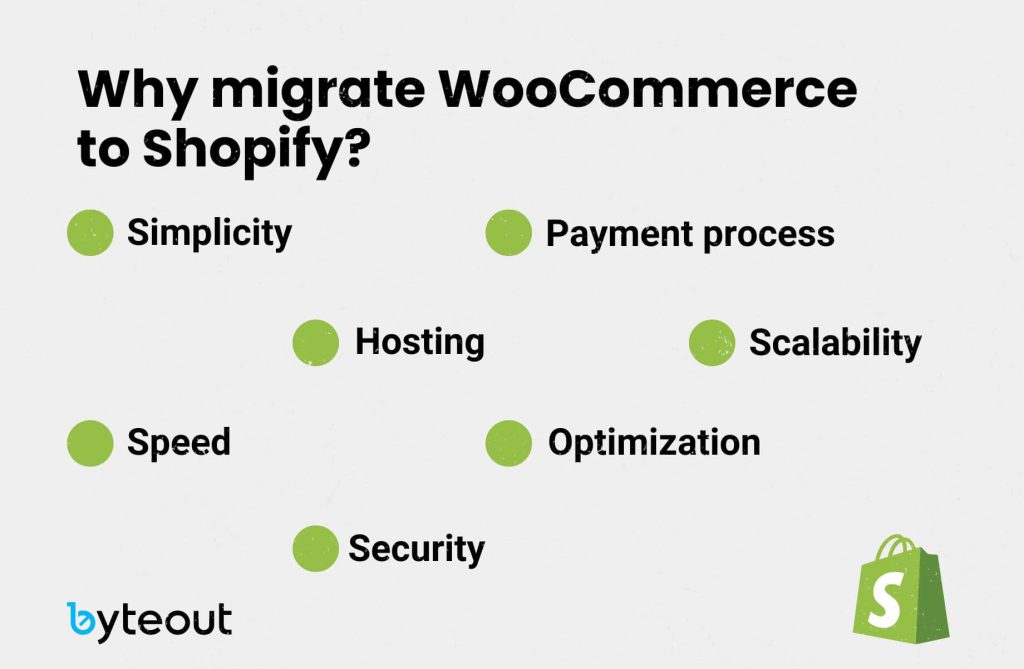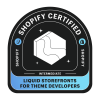
7 reasons why brands choose to migrate WooCommerce to Shopify
Whether brands should migrate WooCommerce to Shopify is a decision that many businesses consider. Each platform has its own set of features, benefits, and limitations, and the decision to switch usually depends on the specific needs and goals of the business.
Table of Contents
Why do people decide to migrate WooCommerce to Shopify?
Here are the 7 most common reasons for this ecommerce platform migration.
1. Intuitive simplicity
Shopify is often perceived as more user-friendly. It offers a straightforward, intuitive interface that can appeal to users who find WooCommerce (based on WordPress) more complex.
One of Shopify’s strongest selling points is its user-friendly nature. The intuitive design of Shopify makes it easy to add products, create discounts, and track orders, all of which can be more complex tasks in WooCommerce. This simplicity can be a huge relief for business owners who want to focus more on their business and less on navigating a complex website.
2. All-inclusive
Shopify stands out because it’s a full package—it takes care of the hosting, security, and maintenance for you. This means you don’t have to worry about the technical side of keeping your site online, protecting it against threats, or keeping things up to date—it’s all included.
On the other hand, with WooCommerce, you’re in charge of finding your own web host, making sure your site is secure, and updating software, which can be pretty demanding and technical.
3. Fast & reliable
Shopify is known for its reliability and high performance. Being a hosted solution, it manages the server load, ensuring faster loading times and better overall performance. This means you can expect quick-loading pages and a responsive shopping experience for your customers, which is a real step up from managing your own site with WooCommerce.
WooCommerce can be tricky if you’re not familiar with the technical aspects of website hosting. Shopify’s infrastructure is designed to handle surges in traffic without a hitch, making it a dependable choice for business owners who want to ensure their online store is always performing at its best.
You’d like to migrate WooCommerce to Shopify? We’d love to hear about your project! ✨

4. Smooth transactions
Shopify simplifies the payment process by offering its own gateway, Shopify Payments, which is streamlined to work seamlessly with your store. It also supports a variety of other payment options, making it easier to set up and offer customers different ways to pay.
This can be a lot more straightforward than with WooCommerce, where you have to set up each payment method one by one, which can be a bit of a hassle. With Shopify, you can get your store’s payment system up and running quickly and with less struggle.
5. Built-in security
Shopify takes care of all the security aspects, providing a secure platform for online transactions.
On the other hand, with WooCommerce, you are responsible for security. Ensuring your site is safe can be quite a task. Shopify’s all-in-one secure environment really is an advantage.
6. Smart scaling
Shopify can be more easily scalable for growing businesses. It’s built to manage more products, more sales, and more customer visits without you having to worry about the technical side of things. This scalability means that as your business expands, Shopify is ready to grow with you.
7. Perfect in all sizes
Shopify stores are generally very well-optimized for mobile devices, an essential factor given the increasing prevalence of mobile commerce. This mobile optimization means that no matter how customers find you, your store will give them a great shopping experience.

What does the process of switching between ecommerce platforms look like?
The first step involves the development team setting up a Shopify account and planning the migration process, as it involves identifying the specific tools and methods Shopify offers for seamless integration.
The team then begins the process of data migration. This includes a full transfer of products, customer and order details, and other data. To make sure accuracy and security are kept, they use Shopify’s app for transfer or opt for specialized third-party services. The process involves:
Step 1: Exporting data from WooCommerce
This is done by generating CSV files of products, customers, and orders. The team ensures these files are correctly formatted, and all necessary data is included.
Step 2: Importing to Shopify
The team uploads these CSV files into Shopify. They pay close attention to data alignment, ensuring that product SKUs, customer email addresses, and order histories are accurately reflected in the new system.
Step 3: Theme selection and customization
The team selects a Shopify theme that closely matches or enhances the existing WooCommerce store design, ensuring brand consistency. They then customize this theme to the business’s specific needs, adjusting the layout, color scheme, fonts, and any specific UX/UI elements that are key to the brand’s online presence.
Step 4: SEO preservation
The team methodically maps old WooCommerce URLs to maintain SEO rankings to new ones on Shopify. This involves creating redirects for each product, category, and page, ensuring that search engines and old bookmarks lead to the correct pages on the new site.
Step 5: Apps and plugins integrations
The team carefully selects and integrates essential Shopify apps and plugins that match or boost the functionalities of the WooCommerce store. This can include apps for email marketing, customer reviews, inventory management, and more. They ensure these integrations are seamless and fully compatible with the new Shopify environment.
Step 6: Testing
Before going live, the team undertakes extensive testing, which includes functional testing, to make sure all features, such as product searches, checkout processes, and user account management, work flawlessly, and load testing, during which they check how the new site performs under high traffic conditions.
Step 7: Final launch
The team proceeds with the final launch once testing is complete and all functionalities are verified. Post-launch, they continue to monitor the site closely for any issues, ensuring a smooth transition for the business and its customers.
Migrate WooCommerce to Shopify? Yes, if you ask us!
Deciding to migrate WooCommerce to Shopify can be transformative for many businesses as it streamlines operations and increases customer experience. Here’s why you should go for it.
- Shopify stands out for its intuitive interface, offering a more straightforward experience compared to the more complex WooCommerce platform.
- Unlike WooCommerce, which requires you to manage hosting, security, and updates, Shopify is a hosted solution that takes care of these aspects.
- Shopify’s infrastructure is optimized for high performance and scalability, allowing businesses to grow without worrying about server load or site speed.
- Shopify’s superior mobile optimization ensures that stores provide an excellent user experience on mobile devices – this is increasingly important as more consumers shop on their phones.
With Shopify, businesses can focus more on growing their operations and less on the technical complexities of running an online store. We hope we helped with the struggle! So, if you’re considering a migration from WooCommerce to Shopify and looking for a seamless transition, our agency specializes in making this process stress-free with a friendly team ready to move your store to Shopify (and to the next level)!

